The conflict in Yemen has been described as the largest humanitarian crisis of this century. International coverage of the situation, however, is limited, especially considering the Saudi-led coalition’s intervention that started in March 2015. Some, however, have argued that the coalition has committed crimes in Yemen. In this article Just War Theory will be used to analyse the Saudi-led coalition’s intervention in Yemen. Because of its moral focus Just War Theory can help leaders decide not if they could go to war, but rather if they should. By analysing the information that was available when the decision to intervene was made (jus ad bellum), and by looking at the execution of the intervention (jus in bello), we can get a more complete image of the intervention. Instead of determining whether the intervention is legal, this article analyses to what extent the Saudi-led coalition’s intervention in Yemen is just.
Birgit Kruitwagen, MSc*
The United Nations Office for the Coordination of Humanitarian Affairs has called Yemen the ‘largest humanitarian crisis in the world’ with ‘two-thirds of the population… need[ing] assistance.’[1] However, most Western governments have either remained eerily silent or have failed to take any real action beyond reprimanding and condemning different parties to the conflict.[2] Several countries have, however, given their support to a coalition of countries led by Saudi Arabia, either in a direct or more indirect way. The Saudi-led coalition, which includes several countries in the region,[3] has been carrying out military operations in Yemen since 2015.
The Saudi-led coalition started its operations after Abdrabbuh Mansour Hadi, President of Yemen, called for help in March 2015. Hadi had been elected president in 2012 after his predecessor, Ali Abdullah Saleh, resigned after months of protests during the Arab Spring. Discontent over the political situation, however, continued after Hadi was appointed. The main area of unrest seemed to be in the northwest of Yemen where Ansar Allah, a Shia-dominated armed group often referred to as the Houthis, increasingly held power. Over the course of 2014 and early 2015 the Houthis, supported by former President Saleh, who still had the loyalty of a part of the country’s military and had access to (heavy) weapons, seized power in large parts of the West of the country.[4] After taking the capital Sana’a, they forced President Hadi to resign. Hadi managed to flee to the southern port city of Aden in February 2015 and left Yemen later that year as the Houthis continued their march southwards.[5] Having found refuge in Saudi Arabia, Hadi pleaded for help.
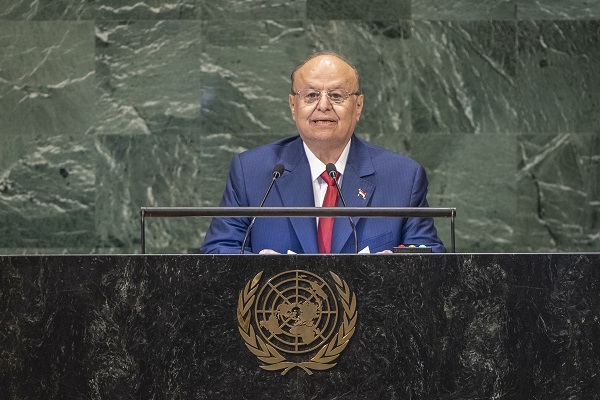
The Saudi-led coalition started its operations after President Mansour Hadi fled in 2015 and called for help. Photo UN, Cia Pak
An international coalition led by Saudi-Arabia decided it was indeed time to intervene and launched an intervention consisting of a bombing campaign against the Houthis, supported by ground forces and air, ground and naval blockades.[6] In a letter to the UN, the coalition argued that the intervention was intended to come to the aid of Hadi, who they argued was the legitimate President of Yemen, to create stability in the region and to protect the Yemeni people from Houthi aggression.[7] While the intervention was not authorized by a United Nations Security Council (UNSC) resolution, the UN appeared to accept the coalition’s actions, arguably also because of the spread of Islamist-Jihadi organizations, such as Islamic State (IS) and Ansar al-Sharia, a parallel group of Al-Qaeda in the Arabian Peninsula (AQAP), in Yemen. Several prominent UNSC members, such as France, the UK and the US, have supported the coalition, either in a direct or more indirect way.[8] The continued rumours and reports that the Houthis have been supported by Shia power Iran arguably also contribute to the support the coalition has received from several Western countries.
The coalition questioned
The international perspective on the coalition did, however, somewhat change when, in a report by the UN Secretary-General published 20 April 2016, a so-called ‘blacklist’ was presented in which the Saudi-led coalition was included as a party that both kills and maims children, and attacks schools and/or hospitals.[9] The UNSC, however, issued an addendum on 24 June 2016, stating that the coalition had been removed from the list pending review.[10] This controversial decision led to increased criticism by several individuals and organizations that continued to argue that the coalition was committing crimes in Yemen.[11]
While the coalition continuously argues that its intervention in Yemen is justified, it has been accused of having questionable motivations and committing war crimes. Investigation into the accusations, however, has proven to be difficult, in part because of the diplomatic power of (mainly) Saudi Arabia and the international support for the coalition. While several critical reports have been published on the role of the coalition in the deteriorating situation in Yemen, virtually none have analysed the Saudi-led coalition’s intervention as a whole, taking into consideration both the decision to intervene and the execution of the stated goals and plans. Such an analysis is, however, possible: by analysing whether the intervention is just by using Just War Theory.
Just War Theory
Just War Theory is a tradition of military ethics that, rather than looking at strictly legal aspects of starting or getting involved in a war, focuses more on the moral side of war. Famous Just War theorist Michael Walzer, in his work ‘Just and Unjust Wars’, argued that Just War Theory refers to ‘the moral law, to those general principles that we commonly acknowledge, even when we can’t or won’t live up to them.’[12] Just War Theory supplies parties with a set of criteria to judge if a war will be, or is, just. This can help to morally justify the actions to their own population, the international community and the population of the country in which the war is taking place. On the other hand, if the different aspects of Just War Theory are not ‘followed’, other parties can also use the theory to condemn a war because it is not just.
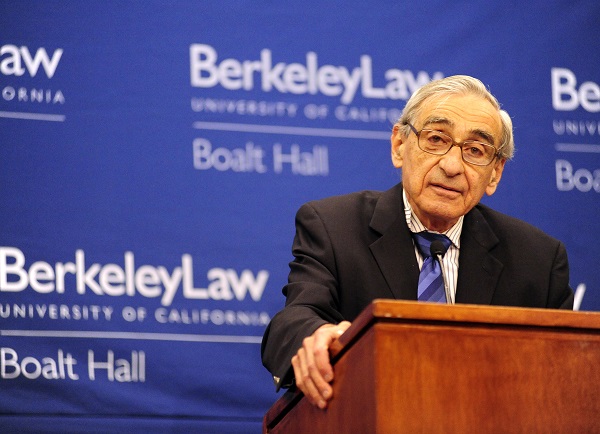
Just War theorist Michael Walzer argued that Just War Theory refers to ‘the moral law, to those general principles that we commonly acknowledge, even when we can’t or won’t live up to them’. Photo University of California/Berkely Law School
Just War Theory is composed of several criteria, which can be divided into two components.[13] The first component, jus ad bellum, or ‘the right to go to war’, focuses on different criteria that should be considered before entering into a war and describes a mainly political process. While various theorists have argued for different principles, jus ad bellum is generally accepted to include (1) the need for a just cause, (2) the idea that only a legitimate authority can make the decision to go to war, (3) the need for the right intent, (4) the consideration if waging war is a proportionate response to the cause, (5) if waging war is the last resort, and (6) if there is a reasonable chance of success.[14] The second component of Just War Theory, jus in bello, or ‘the right conduct in a war’, focuses on principles that should be considered during a war and therefore has a more military focus. It includes the (1) principle of discrimination, meaning that a distinction has to be made between combatants and non-combatants, (2) the principle of proportionality, which means that any harm to civilians or damage to civilian property should be proportional to the military advantage that an attack has, and (3) the principle of necessity, which means that some actions can be considered just during war if they meet a certain level of military necessity.[15] While failing to meet one or multiple criteria means that a war can no longer be considered to be just, one should still try to make the war less unjust by trying to meet the other criteria. In the next section the jus ad bellum criteria of Just War Theory will be applied to the Saudi-led coalition’s decision to intervene in Yemen, followed by the application of the jus in bello criteria.
Jus ad bellum
Just cause
In order to establish whether the Saudi-led coalition had a just cause for its intervention in Yemen, the coalition’s motivations need to be analysed first. In a letter to the UN, the coalition countries argued that they wanted to come to the aid of Hadi, the legitimate President of Yemen, to create stability in the region (self-defence) and to protect the Yemeni people from Houthi aggression (humanitarian intervention).[16] These three goals will be discussed below.
Self-defence, according to Just War Theory, can either be individual or collective. While the UN Charter also allows for both individual and collective self-defence under certain circumstances, Just War theorists do not believe in the need for UNSC approval before starting a war. According to Just War Theory, states can go to war in order to right a wrong, without seeking revenge, or when under a realistic threat.[17] As Walzer argued, ‘states may use military force in the face of threats of war, whenever the failure to do so would seriously risk their territorial integrity or political independence.’[18]
In a letter to the United Nations, Saudi-Arabia, Qatar, Kuwait, the UAE and Bahrain argue for the need for collective self-defence, stating that ‘the presence of heavy weapons and short and long-range missiles beyond the control of the legitimate authorities [in Yemen] poses a grave and ongoing threat to our countries… They [the Houthis] recently carried out large-scale military exercises using medium and heavy weapons, with live ammunition, near the Saudi Arabian border. The Houthi militias have already carried out a bare-faced and unjustified attack on the territory of Saudi Arabia, in November 2009, and their current actions make it clear that they intend to do so again.’[19]
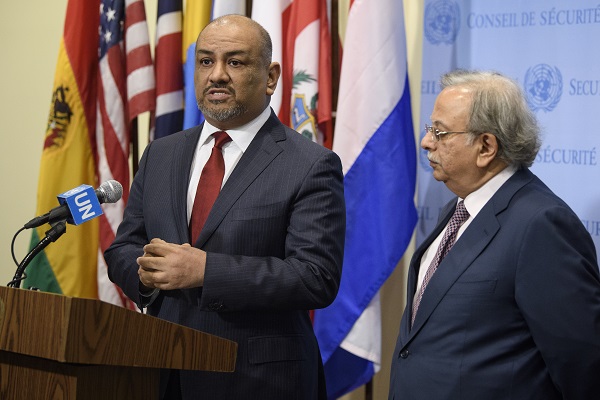
Abdallah Yahya A. Al-Mouallimi (right), Permanent Representative of Saudi Arabia to the UN, and his counterpart from Yemen Khaled Hussein Mohamed Alyemany address the press after the 2015 adoption of resolution 2216 , in which the Security Council demanded that all parties in the embattled country, in particular the Houthis, immediately and unconditionally end violence. Photo UN, Manuel Elias
When one analyses the previous attack that the letter refers to, it can be questioned if self-defence can be claimed. The 2009 attack constituted a series of cross-border attacks by the Houthis, on the one hand, and Saudi forces, on the other, which led to the deaths of over 130 Saudi soldiers.[20] However, this does not justify self-defence six years later. Also, while skirmishes had been taking place near the border shortly before the coalition decided to intervene, they did not result in civilian casualties on such a scale that, as Just War theorists would argue, it would be necessary to call for self-defence.
A second option would be to claim self-defence because an aggressive attack is imminent, justifying pre-emptive self-defence. Pre-emptive self-defence has always been controversial. Grotius, in his time, already argued that ‘The Dread… of our Neighbour’s encreasing Strength, is not a warrantable Ground for making War upon him. To justify taking up Arms in our own Defence, there ought to be a Necessity for so doing, which there is not, unless we are sure, with a moral Certainty, that he has not only Forces sufficient, but a full Intention to injure us … To pretend to have a Right to injure another, merely from a Possibility that he may injure me, is repugnant to all the Justice in the World: For such is the Condition of the present Life, that we can never be in perfect Security.’[21]
Many theorists have supported Grotius’ view after him. A famous quote by US Secretary of State Daniel Webster in 1824 reads that self-defence could be invoked if there is a threat that is ‘instant, overwhelming, leaving no choice of means, and no moment for deliberation.’[22] When analysing the threat the Houthis posed to Saudi-Arabia in the period directly before the coalition’s decision to intervene, it becomes clear this criterion was not met. While Saudi Arabia without a doubt felt threatened by the possibility of Shia Yemenis crossing the border, the information that the Houthis possessed heavy weapons and carried out large-scale military exercises near the Saudi border does not constitute an instant, overwhelming threat that leaves no moment for deliberation and no choice of other means. Thus, according to Just War Theory, the Saudi-led coalition cannot claim pre-emptive self-defence for intervening in Yemen.
Humanitarian intervention, according to several Just War scholars, is problematic by nature. May argues that there is an unavoidable conflict between humanitarian goals and war, as war inevitably brings suffering and death; exactly that which humanitarian intervention aims to stop.[23] The humanitarian situation in Yemen deteriorated by the end of 2014. In December, the UN Office for the Coordination of Humanitarian Affairs stated that 61 percent of the Yemeni population needed ‘some form of humanitarian assistance.’[24] Because of the difficult relationship between protecting human life and war, there has to be a level of certainty that the planned intervention will alleviate suffering; something which is difficult to guarantee, especially if the intervention is in support of a party (in this case the Hadi government) that has been accused of violating human rights itself.[25] Also, while there is no denying that many people in Yemen were suffering terribly, the threshold that would allow humanitarian intervention is rather high. As Orend argues, humanitarian intervention only constitutes a just cause when ‘the domestic citizenry is not only desperate but doomed without international armed rescue.’[26] This was not the case; instead of armed rescue, a better option might have been increasing humanitarian aid, as it could have lifted part of the humanitarian suffering without intensifying the war. Taking this into consideration, it could be argued with hesitation that while the humanitarian situation in Yemen was dire, a purely humanitarian intervention did not constitute a just cause under Just War Theory at that very moment.
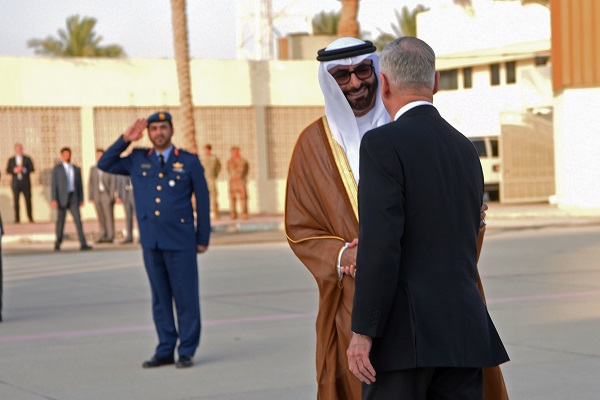
Former U.S. Secretary of Defense James Mattis is welcomed by his United Arab Emirates collegue Mohammed bin Rashid Al Maktoum; together with Saudi-Arabia, Qatar, Kuwait and Bahrain, the UAE has argued for the need for collective self-defence. Photo U.S. Department of Defense, Lisa Ferdinando
The concept of defending a legitimate government as constituting a just cause for war has rarely been discussed under Just War Theory. Hadi called for international support under article 51 of the UN Charter; a questionable decision, since article 51 applies only to international conflicts. While it could be argued that Hadi used Iranian involvement to categorize the conflict as being international, there was a lack of evidence of such involvement at the time. Furthermore, it can be argued that Hadi lacked legitimacy at the time of his plight. President Hadi was elected in 2012, getting over 99 percent of the votes, and was internationally recognised by, for example, the US, China and Russia.[27] However, his internal legitimacy seems to have decreased over the years. When he was elected president he was the only candidate on the ballot, for a two-year term that was supposed to end in 2014 but which has since been extended without new elections.[28] After Hadi fled, first to Aden and later to Saudi Arabia, he continued his rule over only a part of Yemen in exile. ‘As such, the legality of the Saudi campaign is [relying] upon the questionable legitimacy of an exiled ruler,’[29] Dyke summarized. Just War Theory has very strict limitations on what constitutes a just cause. Therefore, it can be concluded that most Just War theorists would not see defending President Hadi as constituting a just cause.
Legitimate authority
The second jus ad bellum criterion is legitimate authority. According to Just War Theory, Fabre explains, legitimate authorities are ‘sovereign political organizations with the power to enforce laws within a given territory.’[30] This includes coalitions of states.
In the case of the Saudi-led coalition, the decision to intervene in Yemen was made by the state leaders of a coalition of states, which constitutes a legitimate authority to enter a war. Enemark and Michaelsen argue that in some cases a coalition of countries is especially qualified to make the decision to enter a war, as ‘coalitions within a particular region may often be more sensitive to the issues behind the conflict, more familiar with the actors and personalities involved, and usually have a greater stake in overseeing a return to peace and prosperity.’[31] Therefore, according to Just War Theory, the Saudi-led coalition is a legitimate authority to enter into a war.
Right intention
The third jus ad bellum criterion is right intention. When analysing whether the Saudi-led coalition had the right intentions for intervening in Yemen, it becomes clear that the concept can be quite ambiguous. In official statements, the intentions behind the intervention were preserving the Yemeni state under President Hadi, protecting the Yemeni citizens from Houthi aggression, and creating stability in the region.[32] These intentions do fulfil the criteria as described by Augustine in his time, who argued intentions are right when a war is waged for securing peace, punishing evildoers and uplifting the good.[33] However, it can be argued that the on-going conflict between, on the one hand, Saudi Arabia, supported by other GCC countries, and Iran, on the other, should also be considered as a possible intention. The coalition had already accused Iran of supporting the Houthis before the start of the intervention,[34] and the coalition seems to fear Iranian Shia expansion in Yemen.[35] Also, the economic interests several regional countries have in Yemen’s coastline, in particular when considering the important Strait of Bab-al-Mandeb used for oil export, should also be seen as one of the coalition’s possible intentions for intervening in Yemen.[36]
It is not necessarily wrong for the effects of an intervention to serve the interest of the intervening party. It is important whether the initial intent was based on self-interest, or whether it is merely an additional benefit of serving a right intention. In order to answer this question information is needed, which often only those who make the decision to intervene, have. This makes it difficult to establish whether the coalition had the right intention for intervening in Yemen. When looking at the official statements, arguably the intent was right; when considering the intentions that many believe lie under the surface, it would appear that most Just War theorist would argue it was not.
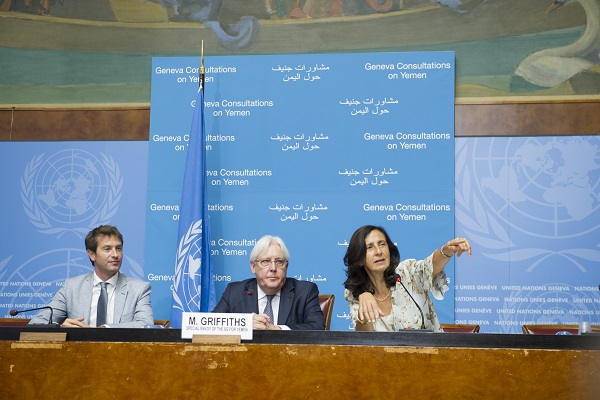
At the Geneva Consultations on Yemen in September 2018, amongst other subjects the character of the intervention in the country was discussed. Photo Violaine Martin
Last resort
The fourth jus ad bellum criterion is last resort. While ‘last resort’ might suggest that one should only become involved in a war when every other option has been tried and failed, the requirements are not so strict. As Fisher argues, ‘war should be… preferred only if other options are judged unlikely to succeed.’[37] Thus, while for example diplomatic and economic sanctions should be used first, if it becomes clear that these sanctions do not work and are unlikely to work in the near future, war can be waged as a last resort (if, of course, the other jus ad bellum criteria are met).
Before the Saudi-led coalition’s decision to intervene in Yemen, several other measures had been taken. The UNSC, for example, had issued several statements condemning the Houthi’s acts of violence and their violation of agreements that they had signed.[38] The Houthi’s non-compliance with treaties they signed, and the lack of results of sanctions, leads me to argue that under Just War Theory the intervention can be considered to have been the last resort.
Reasonable chance of success
The fifth jus ad bellum criterion is the need for a reasonable chance of success. According to Just War Theory, Elshtain explains, one has to ‘be certain before you intervene, even in a just cause, that you have a reasonable chance of success.’[39] The chance of success is influenced by both the military means of the intervening country and its adversary’s strength.[40] In the case of the intervention in Yemen it is difficult to determine the Houthi’s actual strength. While there were rumours that the Houthis were supported militarily by Iran, there was a lack of evidence concerning (the extent of) this support during the start of the intervention. Houthi forces on several occasions managed to seize (heavy) weapons and missiles that belonged to the Yemeni government, for example when they took control of Sana’a.[41]
However, it would seem that the military power of the coalition countries combined would far exceed the Houthi’s military capacity. While the UNSC’s statement of support for the coalition came after the coalition made the decision to intervene, the UNSC was not unfavourable towards the coalition’s causes. For example, the UN had already adopted several resolutions strongly deploring the Houthi’s actions.[42] In case the rumours on Iranian support were true, most other countries in the region still either supported the Saudi-led coalition, or were at least not sympathetic to Iranian influence in the region. This increased the coalition’s chances of being able to block the smuggling of (Iranian) weapons to Houthi forces. Therefore, according to Just War Theory, the Saudi-led coalition’s plans for intervention had a reasonable chance of success.
Proportionality
The final jus ad bellum criterion is the need for proportionality, which requires that the intended response fits the cause, May explains.[43] The coalition’s causes, as mentioned before, were to come to the aid of Hadi, to create stability in the region (self-defence) and to protect the Yemeni people from Houthi aggression (humanitarian intervention).[44] The coalition reportedly intended to start the intervention with 150,000 soldiers and some 200 fighter jets and navy units.[45] The fact that besides Saudi Arabia no coalition member was willing to supply ground troops suggests a focus on airstrikes. This could be problematic, I argue. The Houthis are not a conventional army; they do not necessarily wear official uniforms, giving them the ability to blend into daily civilian life. Therefore, airstrikes on Houthi targets could result in a large amount of civilian casualties. Civilian casualties are warranted, but only if they are in proportion to the results that are achieved.
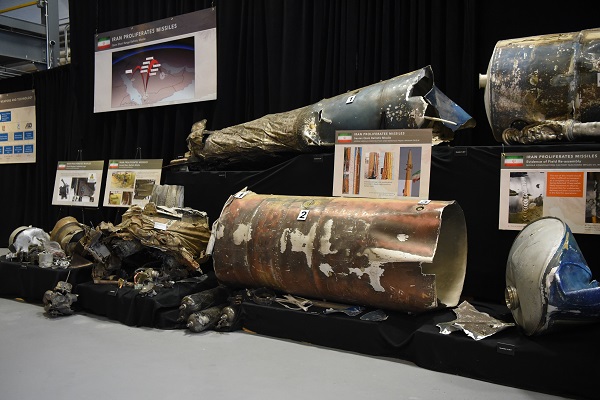
The U.S. Department of Defense established the Iranian Materiel Display to present evidence that Iran is arming dangerous groups with advanced weapons in Yemen, Afghanistan and Bahrain. Photo U.S. Department of Defense, Lisa Ferdinando
Most Just War theorists would argue that the force the coalition intended to deploy is not a proportionate response to the actual and perceived threat the Houthis posed to the coalition countries. Also, coming to the aid of President Hadi with 150,000 soldiers, while he had a questionable internal legitimacy, cannot be considered proportionate. The Houthis had, however, rapidly taken large parts of Yemen with the support of forces loyal to former President Saleh,[46] using violence while marching on Aden at an alarming pace.[47] While it remains difficult to assess if the intended response would not do more harm than good, it could be argued, with some hesitation, that in terms of Just War Theory the coalition’s intended response could be considered proportionate only to the cause of protecting the people of Yemen from Houthi violence.
Jus in bello
Discrimination
The first jus in bello criterion that should be considered when making sure a war is fought justly is the principle of discrimination, which means that force cannot be used indiscriminately: a distinction has to be made between legitimate and illegitimate targets. Combatants constitute legitimate targets: they have the right to take up arms and to harm or kill the enemy; conversely, they lose their right to protection from reciprocal violence.[48]
While non-combatants, on the other hand, have immunity and should not be directly targeted, it is under certain circumstances accepted that they are unintentionally harmed. Aquinas explained this as the ‘double-effect’: there can be both intended and unintended consequences of war.[49] A factory that produces weapons, for example, would constitute a legitimate target, Orend explains.[50] The civilians who work there, however, would not. As the intent cannot be to kill civilians, bombing the factory during working hours would not be acceptable under Just War Theory. Also, some weapons, such as cluster munitions, tend to have a higher risk of harming civilians.[51] Because of this, their use would increase the risk of not meeting the discrimination criterion.
Since the start of the intervention, the coalition has been criticised because of the number of civilians that allegedly have been killed or injured in coalition attacks. According to Al Jazeera, the coalition executed around 16,305 air raids (some of them consisting of several strikes) in Yemen between the start of the intervention and February 2018.[52] While the majority of the raids targeted military sites, 31% of the targeted sites were non-military, consisting of, for example, residential areas, schools, mosques and factories crucial for the production of food.[53]
Amnesty International has investigated several Saudi-led coalition strikes. It found that in some cases non-combatants were harmed while there was no evidence that the targeted locations were being used for military purposes. This would indicate, Amnesty International argues, that the coalition forces ‘failed to take the necessary precautions to minimize potential harm to civilians in the area.’[54] This view was later shared by a Panel of Experts on Yemen, tasked by the UNSC, which argued that civilians and civilian infrastructure were targeted disproportionally and that there was no evidence that suggested any of the parties involved, including the coalition, had taken the appropriate measures to mitigate the impact the attacks had on the civilian population. [55] Moreover, the coalition has on several occasions used weapons and ammunition that are imprecise, indiscriminate and possibly lethal in a wide circle around the point of impact.[56] The Landmine and Cluster Munition Monitor reported at least 23 cluster munition attacks carried out by the Saudi-led coalition between April 2015 and early 2017.[57]
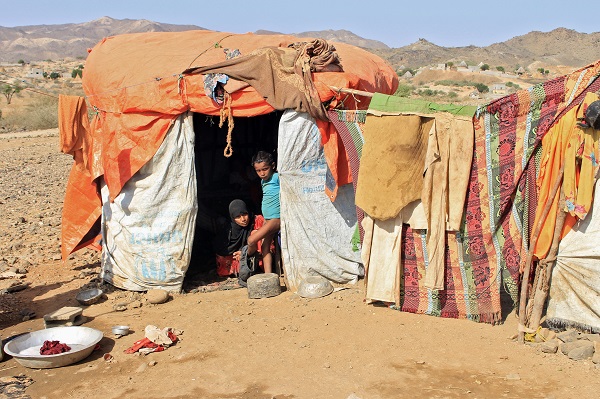
The coalition intiated a blockade to stop military equipment from entering the country, but that also further deteriorated the humanitarian conditions in Yemen. Photo ANP/AFP, Essa Ahmed
The coalition has also received a lot of backlash over the more indirect humanitarian implications of its actions. The coalition imposed an air- and naval blockade on Yemen after the Houthis fired a ballistic missile that was intercepted close to Riyadh in November 2017. The blockade meant that virtually no humanitarian supplies were able to reach Yemeni civilians for several days, and organizations have reported that they continue having trouble getting supplies into the country.[58] While the coalition claimed that the intentions behind the blockade were to stop arms and other military equipment from entering the country, thus trying to make the war end more quickly, the blockade also further deteriorated the humanitarian conditions in Yemen.[59]
The Coalition has continuously argued that it is committed to implementing humanitarian law and alleviating the suffering of the Yemeni people.[60] The coalition’s lack of investigation into possible civilian casualties, however, has led to scepticism regarding its dedication to this cause.[61] It would appear that the coalition failed to meet the discrimination criterion on several occasions.
Proportionality
While the concept of proportionality has already been considered as part of jus ad bellum, it is also the second criterion of jus in bello. For a war to be just, the damage that is being done by intervening should not be greater than the damage that the intervention is responding to, Yoder explains.[62] However, assessing military advantage, and weighing it against possible loss of civilian lives, is difficult; especially when considering that it is solemnly based on the information that is available beforehand and not on actual results.[63] Because of this, Kretzmer argues that when innocent persons are killed or wounded as a result of an attack, the party responsible has to ‘show either that this could not reasonably have been foreseen, or that even if it could have been foreseen, the necessity of the attack was urgent enough to justify the risk.’[64]
When considering the proportionality principle in the context of the coalition’s intervention in Yemen, it should be noted that most of the coalition’s air raids have (arguably) targeted military targets. However, there are also reports of cases in which civilians were disproportionality harmed. This was argued, for example, by Amnesty International, as explained before.[65] Also, the UN Humanitarian Coordinator for Yemen, Jamie McGoldrick, reported several incidents in which many civilians were killed or injured. These incidents, McGoldrick stated, ‘prove the complete disregard for human life that all parties, including the Saudi-led Coalition, continue to show.’[66] Moreover, the previously discussed blockade imposed by the coalition also had a negative impact on civilians. While there were reports that Iran was supplying the Houthis with weapons,[67] which would suggest that the blockade did serve a certain military purpose, the coalition knew without a doubt that the blockade would have humanitarian consequences that would affect already vulnerable non-combatants. Moreover, even after several warnings had been issued by humanitarian organizations because they were unable to get aid into Yemen, the blockade was not (fully) lifted. Therefore, the obvious conclusion is that the coalition has on several occasions carried out attacks, and imposed a blockade, which disproportionately affected the civilian population in Yemen and therefore cannot be considered proportionate according to Just War Theory.

According to UN Humanitarian Coordinator for Yemen Jamie McGoldrick, several incidents in which many civilians were killed or injured, proved a ‘complete disregard for human life’ on the side of the warring parties in Yemen. Photo UNSCO
Necessity
The final jus in bello criterion that has to be met in order for a war to be just is military necessity. Military action is only just if there is no other way of reaching a military goal that is expected to significantly contribute to the end goal of the war.[68] This includes the harming of civilians, but also the destruction of infrastructure or property. For example, bombing a busy marketplace frequented by enemy combatants, while it is known that they will move to an easy-to-target military area, would not pass the test of necessity. However, when targeting a high-profile military leader who is rarely seen in public, it might be considered necessary to bomb his car on a public road knowing that there could be non-combatants in the area that might be harmed. This does mean that what can be considered necessary largely depends on the information that is available at the time.
While the Saudi-led coalition has carried out several attacks that would be considered necessary under Just War Theory, there have also been attacks that would not. For example, attacking residential areas without sound evidence that there are combatants or military equipment present that pose such an imminent threat that taking them out in another time at another place is not an option, suggests there is a lack of necessity.
Also, it is questionable whether a complete blockade as was imposed by the coalition was necessary, as it meant that humanitarian aid could not reach civilians in Yemen. There have been no clues that weapons were smuggled aboard international aid vessels. This would lead to the conclusion that, while increasing surveillance on what goes into Yemen could be considered necessary, placing Yemen on lockdown could not.
Conclusion
It has become clear that while the Saudi-led coalition managed to meet some of the Just War criteria, it failed to meet several others. As argued at the beginning of this article, even when not all criteria are met, it is important to still try to meet the other criteria. However, in order for a war to be truly just, all criteria would have to be fulfilled. Therefore, the intervention was only partly just, meaning it was also partly unjust.
It is interesting to note is that none of the jus in bello criteria were met. This could in part explain why criticism from the international community of the coalition’s intervention in Yemen, to a large extent, only became more prominent well into the intervention. However, this does not justify their lack of reaction during the early months of the intervention. Several jus ad bellum criteria were also not met, especially when taking into consideration the unofficial intents (thwarting Iran, protecting economic interests) that according to many lie beneath the surface.
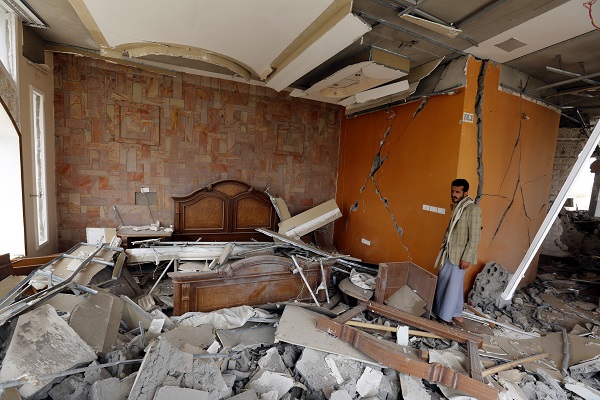
Hashim al-Mutawakel, 27, inspects the ruins of his family home which was destroyed by two airstrikes in the Nahdah neighborhood in the Yemeni capital Sana’a on 8 January 2016. Hashim was not at home that night, but his family, some of whom suffered minor injuries, were in the basement. Photo UNHCR, Yahya Arhab
While, based on Just War Theory, the Saudi-led coalition should not have intervened, the international community should have reminded the coalition of its responsibilities under Just War Theory. Continued research into the different aspects of Just War Theory, and continuing to remind parties of their duties, is an important step in making more people aware of the benefits that adhering to Just War Theory can have. After all, the ‘Just War consideration’ of whether to go to war or not, while not necessarily based on legal grounds, is a question on which many lives, of non-combatants as well as combatants, depend.
* This article is based on the author’s Master’s thesis for the ‘International Crimes and Criminology’ course at the Vrije Universiteit Amsterdam (VU). The research has been done during an internship at the Dutch Ministry of Defence, specifically with the ‘Sectie Cultuur-historische Achtergronden en Informatie’ (Cultural Affairs and Information Section). The author would like to thank dr. Maartje Weerdesteijn and drs. Edwin Maes for their guidance and peer review.
[1] S. O’Brien, ‘Statement to the Security Council on Missions to Yemen, South Sudan, Somalia and Kenya and an Update on the Oslo Conference on Nigeria and the Lake Chad Region’, United Nations Office for the Coordination of Humanitarian Affairs (10 March 2017).
[2] Economic interests arguably play a large role in the lack of international response to the Saudi-led coalition’s role in the suffering in Yemen. For example, while Spain at the beginning of September 2018 announced it had cancelled the delivery of 400 laser-guided bombs purchased by Saudi Arabia, it became clear by the end of October that the government was not willing to stop arms sales so Saudi Arabia. See: A. Parra, ‘Spain cancels bombs sale to Saudi Arabia amid Yemen concerns’, DefenseNews (4 September 2018); C. Penty, ‘Spanish Deputies Reject Proposal to Stop Saudi Arabia Arms Sales’, Bloomberg (23 October 2018).
[3] The coalition includes Saudi Arabia, the United Arab Emirates (UAE), Bahrain, Kuwait, Egypt, Jordan, Morocco, Senegal, and (until 2017) Qatar.
[4] F. Edroos, ‘How did Yemen’s Houthi-Saleh alliance collapse?’, Al Jazeera (4 December 2017); P. Salisbury, ‘Yemen’s former president Ali Abdullah Saleh behind Houthis’ rise’, in: Financial Times (26 March 2015).
[5] M. Ghobari and M. Mukhashaf, ‘Yemen’s Hadi flees to Aden and says he is still president’, Reuters (21 February 2015).
[6] ‘Saudi-led strikes hit Houthi targets across Yemen’, Al Arabiya News (22 June 2015)
[7] United Nations Security Council, ‘Identical letters dated 26 March 2015 from the Permanent Representative of Qatar to the United Nations addressed to the Secretary-General and the President of the Security Council’ (27 March 2015), enclosure.
[8] J. Irish, ‘No sign of France reviewing weapons sales to Saudi-led Yemen coalition: sources’, Reuters (9 February 2018); P. Wintour, ‘Saudi Arabia's standing is damaged despite ruling on arms exports’, in: The Guardian (10 July 2017).
[9] United Nations General Assembly and United Nations Security Council, ‘Children and armed conflict: Report of the Secretary-General’ (20 April 2016), Annex I.
[10] United Nations General Assembly, United Nations Security Council, ‘Children and armed conflict: Report of the Secretary-General, addendum’ (24 June 2016).
[11] Human Rights Watch, ‘Yemen: Saudi-Led Airstrikes Used Cluster Munitions’, Human Rights Watch (3 May 2015).
[12] Walzer, ‘Just and Unjust Wars: A Moral Argument with Historical Illustrations’ (New York, Basic Books, 2015) xxvi.
[13] While some Just War theorists have recently argued for a third component, ‘jus post bellum’, this component will not be discussed in this article as the conflict in Yemen is still on-going.
[14] See for example: E.K. Hendrickson, ‘Just War Theory Applied to US Policy in Pakistan and Yemen’, (Fort Leavenworth, United States Air Force, 2014).
[15] See for example: Hendrickson, ‘Just War Theory’; L. May, Aggression and Crimes Against Peace (New York, Cambridge University Press, 2008).
[16] United Nations Security Council, ‘Identical letters dated 26 March 2015’, enclosure.
[17] Hendrickson, ‘Just War Theory’, 4.
[18] Walzer, ‘Just and Unjust Wars’, 84.
[19] United Nations Security Council, ‘Identical letters dated 26 March 2015’, enclosure.
[20] A. Orkaby, ‘Saudi Arabia's War with the Houthis: Old Borders, New Lines’, The Washington Institute, Policy Watch 2404 (9 April 2015).
[21] H. Grotius, The Rights of War and Peace (Indianapolis, Liberty Fund, 2005 ed.), chap. 22, par. 5.1 and chap. 1, par. 17.
[22] Webster, as quoted in: J.A. Green, The Criteria of Necessity and Proportionality (Portland, Hart Publishing, 2009) 66.
[23] May, ‘Aggression and Crimes Against Peace’, 22.
[24] United Nations Office for the Coordination of Humanitarian Affairs, ‘2015 Yemen Humanitarian Needs Overview: Yemen’ (22 December 2014).
[25] Human Rights Watch, ‘World Report 2015: Yemen. Events of 2014’ (2015); United Nations Security Council, ‘7411th meeting’ (22 March 2015) 6.
[26] B. Orend, The Morality of War (Toronto, Broadview Press, 2006) 92.
[27] S. Ramani, ‘China's Role in the Yemen Crisis’, The Diplomat (11 August 2017); M.N. Katz, ‘Russia Maneuvers between Opposing Forces in Yemen’, The Arab Gulf States Institute in Washington (25 January 2017); S. Ackerman, ‘US gives 'strong support' to Yemen government despite Shia rebel uprising’, in: The Guardian (26 September 2014).
[28] ‘Hadi sworn in as Yemen's new president’, Al Jazeera (25 February 2012).
[29] J. Dyke, ‘Is the Saudi war on Yemen legal?’, IRIN (3 April 2015).
[30] C. Fabre, ‘Cosmopolitanism, just war theory and legitimate authority’, in: International Affairs 84 (2008) (5), 964.
[31] C. Enemark and C. Michaelsen, ‘Just war doctrine and the invasion of Iraq’, in: Australian Journal of Politics & History 51 (2005) (4) 557.
[32] Al Arabiya News, ‘EXCLUSIVE: General Asiri’; The Embassy of The Kingdom of Saudi Arabia, ‘King Salman’.
[33] As quoted in: T. Aquinas, Summa Theologica (year unknown), part II, part II, question 40, article 1.
[34] Y. Bayoumy and M. Ghobari, ‘Iranian support seen crucial for Yemen's Houthis’, Reuters (15 December 2014).
[35] See for example: P. Salisbury, ‘Yemen and the Saudi–Iranian ‘Cold War’’, Chatham House, Middle East and North Africa Programme (2015); C. Shakdam, ‘Yemen at War: The New Shia-Sunni Frontline That Never Was’, in: Foreign Policy Journal (10 April 2015).
[36] P. Saul, ‘Yemen war clouds raise dangers for top oil shipping route’, Reuters (26 March 2015).
[37] D. Fisher, ‘Morality and War: Can War Be Just in the Twenty-First Century?’ (Oxford University Press, 2012) 235.
[38] United Nations Security Council, ‘Security Council Press Statement on Yemen’ (22 February 2015).
[39] J.B. Elshtain, Just War Against Terror: The Burden Of American Power In A Violent World (New York, Basic Books, 2008) 8.
[40] A.E. Eckert, Private Military Companies and the Reasonable Chance of Success (Athens, University of Georgia Press, 2014) 63.
[41] CBS News, ‘Yemen rebels gain ground, al Qaeda gains ‘space’’, CBS News (21 January 2015).
[42] See for example: United Nations Security Council, ‘Resolution 2201, adopted by the Security Council at its 7382nd meeting’ (15 February 2015).
[43] May, ‘Aggression and Crimes Against Peace’, 105.
[44] United Nations Security Council, ‘Identical letters dated 26 March 2015’, enclosure.
[45] D. Al-Shibeeh, ‘Your guide to ‘Operation Decisive Storm’’, Al Arabiya News (26 March 2015).
[46] Salisbury, ‘Yemen’s former president’.
[47] H. Hendawi, ‘Yemen set for civil war as Houthi rebels close in on Aden’, in: The Independent (22 March 2015).
[48] Soldiers who have surrendered themselves or who have been taken prisoner (non-active combatants), however, should be treated well and not be harmed; they no longer constitute a threat and are therefore not legitimate targets. See for example: L.C. Green, The Contemporary Law of Armed Conflict (Manchester, Manchester University Press, 1993) 191-196; Walzer, ‘Just and Unjust Wars’, 136.
[49] A.J. Bellamy, Just Wars: From Cicero to Iraq (London, Polity Press, 2006) 39-40.
[50] Orend, ‘The Morality of War’, 115-118.
[51] A. Royden, An Alternative to Nuclear Weapons? Proportionality, Discrimination, and the Conventional Global Strike Program (Athens, University of Georgia Press, 2014) 116.
[52] The data used by Al Jazeera have been gathered by ‘using open sources and has been cross-referenced using a wide range of information, including official records from local authorities, reports from local and international news agencies, reports by international human rights groups and reports from national and international NGOs.’ Source: ‘Death from Above: Every Saudi Coalition air raid on Yemen’, Al Jazeera (2018).
[53] ‘Death from Above’, Al Jazeera.
[54] ‘‘Nowhere Safe for Civilians’: Airstrikes and Ground Attacks in Yemen’, Amnesty International (2015) 19.
[55] United Nations Security Council, ‘Letter dated 26 January 2018’, 3.
[56] Amnesty International, ‘‘Nowhere Safe for Civilians’’, 21; Amnesty International, ‘Amnesty International Report 2017/18’, Amnesty International (2018).
[57] Landmine and Cluster Munition Monitor, ‘Yemen: Cluster Munition Ban Policy’ (2 August 2017).
[58] Mehr News Agency, ‘Yemen to seal off’; Regional Mixed Migration Secretariat, ‘RMMS Mixed Migration Monthly Summary’, 4.
[59] Amnesty International, ‘Amnesty International Report 2017/18’, 402; UN News Centre, ‘Yemen: As threat of famine looms, UN urges Saudi-led coalition to fully lift blockade of Red Sea ports’ (2 December 2017).
[60] Saudi Press Agency, ‘Coalition Forces Spokesman Expressed Regret for Statement by UN Humanitarian Coordinator for Yemen 2 Riyadh’ (28 December 2017).
[61] J. Merrill, ‘Saudi Arabia ignores hundreds of civilian death reports in Yemen inquiry’, Middle East Eye (12 February 2018).
[62] J.H. Yoder, When war is unjust: Being honest in just-war thinking (Eugene, Wipf and Stock Publishers, 2001) appendix V, sec. VII, par. A.
[63] D. Kretzmer, ‘Targeted Killing of Suspected Terrorists: Extra-Judicial Executions or Legitimate Means of Defence?’, in: The European Journal of International Law 16 (2005) (2) 200-201.
[64] Ibid., 201.
[65] Amnesty International, ‘‘Nowhere Safe for Civilians’’, 18.
[66] United Nations Office for the Coordination of Humanitarian Affairs, ‘Statement on Behalf of the Humanitarian Coordinator for Yemen, Jamie McGoldrick, on Mounting Civilian Casualties’ (28 December 2017).
[67] The UN Panel of Experts on Yemen did identify ‘…missile remnants, related military equipment and military unmanned aerial vehicles that are of Iranian origin and were brought into Yemen’ (United Nations Security Council, ‘Letter dated 26 January 2018’, 2). However, this report was published after the blockade was imposed.
[68] Walzer, ‘Just and Unjust Wars’, 147.